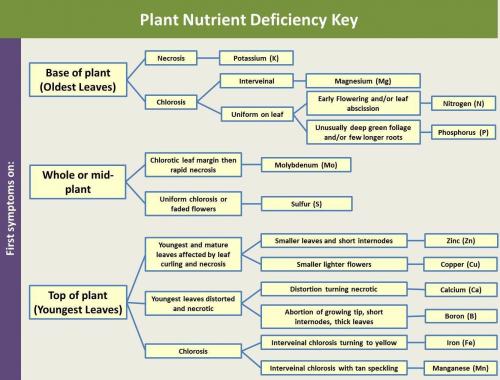Six steps to identifying nutrient deficiencies in ornamental plants
Growers should follow these six steps to identify nutrient deficiencies in plants and make appropriate management decisions.

Greenhouse growers in Michigan are busy wrapping up transplanting and shipping their product. In the flurry of the season, growers may overlook nutritional disorders in their crops. Most growers have trouble identifying nutrient deficiencies because many of the nutrient deficiencies create similar symptoms. So, how can you tell what nutrient is deficient?
Michigan State University Extension recommends these six steps in order to identify nutrient deficiencies:
- Growers should eliminate that the symptoms are being caused by a biotic organism or from another environmental factor. For example, nutritional issues within the crop are rather consistent among plants and are not spotty within the crop.
- Use the pour-thru or saturated media methods to test the pH and electrical conductivity (EC) of symptomatic plants. Are they within the normal range for that crop? Is your pH and EC meter calibrated correctly?
- Growers should examine where on the plant the symptoms began or appear. Since some elements are mobile while others are immobile in the plant, the symptoms of the deficiency will be expressed in either the base of the plant on the oldest leaves, the top of the plant on the youngest growth or on whole plant.
- Then, growers should use the plant nutrient deficiency key (see figure below) to help determine which nutrient is deficient. Growers can then use this key to come up with a hypothesis as to which element is causing the plant’s symptoms. It’s fairly common for there to be more than one nutrient deficiency, which makes this process more challenging.
- While this deficiency key can provide growers with a starting point, we recommend growers submit a media sample for analysis of both macro- and micro-nutrients.
- Contact your local floriculture educator or specialist to help you interpret the results from the media analysis.
By following these six steps, growers will diagnose nutrient deficiencies correctly which also provides them better information to make management decisions on crops.
To learn more about symptoms of nutrient deficiencies in petunias and about the importance of water alkalinity in plant nutrition, check out my recent e-GRO alert, “Keep an Eye on Nutrition.” To learn more about managing your water quality to prevent nutritional issues, check out, “Tracing Water Quality Back to the Source.”

Plant nutrient deficiency key. See the key in full text below.
- Base of plant (oldest leaves)
- Necrosis
- Potassium (K)
- Chlorosis
- Interveinal
- Magnesium (MG)
- Uniform on leaf
- Early flowering and/or leaf abscission
- Nitrogen (N)
- Unusually deep green foliage and/or few longer roots
- Phosphorus (P)
- Early flowering and/or leaf abscission
- Interveinal
- Necrosis
- Whole or mid-plant
- Chlorotic leaf margin then rapid necrosis
- Molybdenum (Mo)
- Uniform chlorosis or faded flowers
- Sulfur (S)
- Chlorotic leaf margin then rapid necrosis
- Top of plant (youngest leaves)
- Youngest and mature leaves affected by leaf curling and necrosis
- Smaller leaves and short internodes
- Zinc (Zn)
- Smaller lighter flowers
- Copper (Cu)
- Smaller leaves and short internodes
- Youngest leaves distorted and necrotic
- Distortion turning necrotic
- Calcium (Ca)
- Abortion of growing tip, short internodes, thick leaves
- Boron (B)
- Distortion turning necrotic
- Chlorosis
- Interveinal chlorosis turning to yellow
- Iron (Fe)
- Interveinal chlorosis with tan speckling
- Manganese (Mn)
- Interveinal chlorosis turning to yellow
- Youngest and mature leaves affected by leaf curling and necrosis



 Print
Print Email
Email




